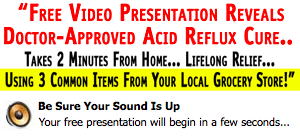December 21, 2011
Symptoms of Hiatal Hernia; Hiatal Hernia Symptoms and Treatment Options
Whenever an internal body part gets displaced from its normal position and moves into a foreign area — that is, somewhere it does not belong — a hernia occurs. A hiatal hernia describes a condition in the stomach and part of the esophagus pushes through the hiatus, a small opening in the diaphragm.
The diaphragm is a dome-shaped wall of muscle that separates the chest cavity from the abdominal cavity. The esophagus, also known as the food pipe, normally passes through the hiatus and connects to the stomach. Because the stomach can sometimes bulge through this opening, there exists the potential for a hiatal hernia.
Small hiatal hernias are typically painless, and they cause no major health problems. In fact, many people do not realize they have a hiatal hernia, until their doctor discovers the during a medical examination for something else.
Larger hiatal hernias are usually uncomfortable and problematic. They allow partially-digested food and stomach acid to back up into the esophagus, creating acid reflux and heartburn. The heartburn caused by hiatal hernias can become severe enough to cause upper abdominal pain or chest pain, which is often mistaken for heart attack pain. A proper medical diagnosis is extremely important.
What Causes Hiatal Hernia?
Hiatal hernias result from weak muscle tissue that allows the stomach to bulge through the diaphragm and into the chest. The exact cause is uncertain. Increased and prolonged abdominal pressure — caused by obesity or overweight, pregnancy, coughing, vomiting, stressful bowel movements, or heavy lifting — may contribute to the development of hernias.
Injuries to the area can also cause hiatal hernia. And some people are simply born with a large hiatal opening. Women are more likely than men to experience hiatal hernias, and the condition is more common in overweight individuals and people who have seen at least 50 years of age.
Two Types Of Hiatal Hernia
While medical experts cannot say what causes hiatal hernia, they have identified two main types: sliding hernia and para-esophageal hernia. The first type occurs in the chest, and the latter comes near the esophagus.
A sliding hernia is the more common type of hiatal hernia. It occurs when the stomach, along with part of the esophagus that joins the stomach, pushes into the chest cavity through the hiatus. The condition may or may not cause symptoms.
Para-esophageal hiatal hernia is far less common, but it is much more serious. While the stomach and esophagus remain in their normal positions, part of the stomach bulges through the hiatus and lands next to the esophagus. Many people with para-esophageal hernia never experience symptoms. But the condition is dangerous, because it may “strangle” the stomach and cut off the blood supply.
Hiatal Hernia Symptoms
Small hiatal hernias typically produce no obvious signs or symptoms. Generally the sliding hernia type, these hernias are not associated with any significant health problems. On the other hand, large hernias are likely to produce noticeable symptoms. These include heartburn, belching, swallowing difficulties, and fatigue. The larger the hernia, the more noteworthy and problematic the symptoms become.
When large sliding hiatal hernias do produce symptoms, they are usually related to gastroesophageal reflux disease, also known as GERD. The connection stems from the fact that hernia formation interferes with the lower esophageal sphincter, the barrier muscle that prevents stomach acid from backing up into the esophagus.
People who suffer from gastroesophageal reflux disease are much more likely to have hiatal hernias than those who are unaffected by GERD. This suggests that hiatal hernias somehow contribute to GERD. Nevertheless, GERD can occur without a hiatal hernia, so it is evident that other factors also contribute to the disease.
Hiatal Hernia And GERD
Various mechanisms in the body work to prevent acid reflux, a term for the backwards flow of stomach acid into the esophagus. One mechanism involves the lower esophageal sphincter, the band of muscle where the esophagus meets the stomach.
Most of the time, this muscle remains contracted to prevent acid reflux and regurgitation. It relaxes only to allow food to move from the mouth, through the esophagus, and into the stomach. The esophageal sphincter muscle is attached to the diaphragm at the hiatal opening. The diaphragm muscle, which wraps around the sphincter, increases the pressure to further prevent reflux.
A valve-like tissue just below the sphincter is another mechanism to prevent acid reflux. Since there is only a slight connection between the esophagus and stomach, a sharp angle exists between the two. Thin tissue, formed from the walls of the stomach and esophagus, forms a valve that closes the esophageal opening when pressure occurs in the stomach.
Two important changes take place when a hiatal hernia exists. While the lower esophageal sphincter slides up toward the chest, the diaphragm remains in position. Without the muscle overlap and necessary pressure, acid reflux is likely to occur. With the stomach and part of the esophagus pulled into the chest, the sharp angle that normally exists between the two becomes less sharp. As a result, the valve-like effect is weakened. This also promotes acid reflux.
Common GERD Symptoms
Acid reflux, the regurgitation of food or liquid, is a major symptom of hiatal hernia in people with gastroesophageal reflux disease. Some may also experience swallowing problems, a sore throat, hoarseness, a dry cough, and a lumpy sensation in the throat.
Heartburn is another common symptom of hiatal hernia and GERD. The burning sensation characteristic of heartburn sometimes spreads from the chest to the throat. It usually leaves an unpleasant, sour taste in the mouth.
Upper abdominal pain and chest pain are serious GERD symptoms. Because many people confuse it with heart attack pain, it is important to undergo tests and procedures to accurately diagnose the condition.
Diagnosing Hiatal Hernia
More often than not, hiatal hernias are discovered during a test to determine the cause of heartburn, chest pain, or upper abdominal pain. Doctors may x-ray the upper digestive tract using a chalky barium liquid. Or they may use an endoscope, or flexible tube with a light and video camera, to explore inside the digestive tract.
On both an x-ray and endoscopy, a hiatal hernia appears as a “sac” between the stomach and esophagus. Often, the sac is visible only during swallows. Additional medical tests, such as ambulatory acid probes and esophageal motility tests, are used to diagnose GERD.
Hiatal Hernia Treatment
Hiatal hernias without symptoms need no treatment. However, acid reflux and persistent heartburn will probably require medical intervention through medications or surgery.
Acid reflux and heartburn symptoms have several treatment options. Over-the-counter antacids neutralize stomach acid and provide heartburn relief. Special medications called H-2-receptor blockers reduce acid production, and proton pump inhibitors block it. They also heal damaged tissue in the esophagus. If over-the-counter products are ineffective, doctors can prescribe stronger versions.
Medications will control most hiatal hernia symptoms, but sometimes a hernia requires surgery. Medical procedures are usually reserved for emergency situations, including those where prescription drugs offer no symptom relief. Hiatal hernia repairs are often combined with surgery for gastroesophageal reflux disease.
When Is Surgery Necessary?
Constriction or strangulation can cut off the blood supply. If a hiatal hernia is in danger of this happening, surgery may be needed to reduce the hernia. This is more likely to occur with para-esophageal hernias than with sliding hernias.
Hiatal hernia operations involve pulling the stomach back into the abdomen and making the diaphragm opening smaller. Surgeons usually remove the hernia sac and reconstruct the lower esophageal sphincter. This may involve an incision in the abdomen or chest wall.
Many surgeons use laparoscopic surgery to view internal organs from inside the body. This less invasive procedure requires smaller incisions, through which the laparoscope and surgical instruments are inserted. Laparoscopy enables a faster recovery, with less pain, scarring, and risk of infection.
GERD surgery, often combined with hiatal hernia repair, reinforces the lower esophageal sphincter. Surgeons may construct a barrier to prevent the backup of stomach acid. Some surgeons perform surgery to damage the nerves and create scar tissue in the esophagus. While this procedure strengthens muscles and reduces pain, it is usually performed when other surgeries are not an option.
Recovery usually takes two to three weeks, although patients must avoid hard work and heavy lifting for several months after surgery. Despite a procedure’s success, there is no guarantee that a hiatal hernia will not return in the future.
Other Popular Treatments
Lifestyle changes, home remedies, and alternative therapies are other ways to treat symptoms. Hiatal hernia sufferers can alleviate some of their problems by eating smaller meals, avoiding alcohol and cigarettes, and losing excess pounds. Avoiding trigger foods and elevating the head during sleep are two more practical solutions.
Some alternative medicine practitioners claim to cure hiatal hernia by manipulating the stomach and pushing it back into its normal position. However, no medical evidence exists to support their claim.
Patients may turn to acupuncture, relaxation therapies, and herbal remedies to treat GERD symptoms. Studies suggest that acupuncture can help people with persistent heartburn, and relaxation techniques are known to eliminate stress and ease symptoms. Chamomile, licorice, slippery elm, and other herbal remedies are touted as effective dietary supplements.
A Final Word On Hiatal Hernia
When is it time to call the doctor for hiatal hernia problems? Severe abdominal pain or chest pain are two reasons to seek medical attention. Nausea, vomiting, an inability to pass gas, and difficulty with bowel movements are additional indicators. They are signs of possible strangulation or obstruction — an emergency situation that requires immediate medical attention.
For less serious hiatal hernia problems, over-the-counter or prescription medications can usually control the symptoms. No alternative therapy can cure hiatal hernia, and none can reverse the damage already caused to the esophagus. But some people may benefit from holistic treatments that are combined with conventional medicine. To ensure safety and prevent further medical problems, patients should talk to their doctors about complementary therapies before seeking alternative solutions. For more information on treatment for hiatal hernia symptoms be sure to visit Reflux Remedy today.
Filed under Hiatal Hernia Symptoms, Hiatial Hernia by admin










